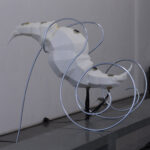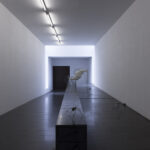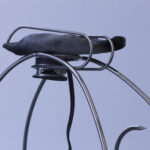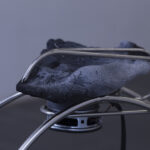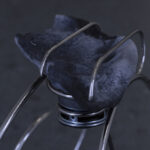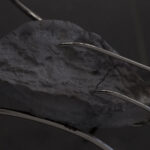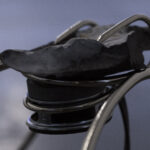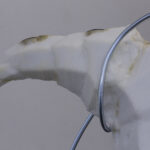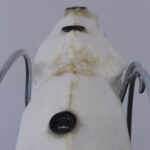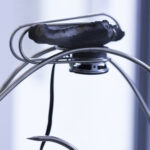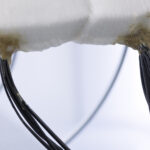Fire‘s Memory 14.01.2024-03.03.2024 SCHLEUSE Opelvillen Rüsselsheim
Selina Hammer || Wingel Mendoza
The interactive sound installation ‘Fire’s Memory’ transforms objects into intangible experiences and sound into tangible ones. The fire melts topological boundaries and reshapes them, allowing materials and textures to flow into each other and solidify into something new. For the synthesis of object and sound, we selected fire as a common material. From an object-sculptural perspective, we chose materials like wax, metal, and ceramic that can be transformed by fire. Sonically, we arranged the transforming points where fire acts and breaks, along with other recordings from the object manufacturing process, into a sound composition. This is not a documentation of the manufacturing process but a series of sounds with their own texture, forming an independent material. This allows not only a direct connection between the sound and its immediate origin, the sounding object, but also the continuation of it, observing the cascade of new and indistinguishable images.
Both perspectives merge in the design: the speakers and cables become an integral part of the object logic. For example, the metallic clips hold both porcelain and speakers, allowing them to evolve into aesthetic objects. The incoming and outgoing cables of the wax object provoke visceral images, resembling umbilical cords leading through the wax object and supplying energy. Organic reference forms like cocoons or claws intensify these visceral images, expanding them through clinical reference points like surgical instrument holders and cool materiality. Large, curved metal arches, reminiscent of basic forms of Art Nouveau ornamental brackets or intertwined legs that seem to crawl forward, create a corporeality whose dynamic formal language communicates with each other. The sound also becomes a unique communication system among the individual sound bodies: the objects echo a murmuring trace of their own material. They whisper half-forgotten songs, excerpts from their own metamorphosis, revealing themselves as miniature entities storing an infinite sonic recurrence of the smallest units: molding, striking, breaking, burning, melting, welding, and cooling.
The sonic communication system consists of two scenarios. The continuous Sound-Ambient scenario is distributed throughout the space via 11 speaker attached to the objects. Field recordings and sounds physically influenced by us are processed into a composition here. The second scenario is triggered by the proximity of the visitors to one point in the space: the wax object. Here, all field recordings and sounds generated by the material itself are arranged.
Another difference lies in the perception of sounds in relation to the objects. More fragile sound spectra are mainly distributed across the 11 speaker, while the fire, as the most powerful recording, is linked to the wax object. This creates a distinction between two different sound spectra, exposing the aesthetics of the objects and vice versa.
From sooty rocks, sounds reminiscent of animals or natural phenomena, to metallically gleaming utopian forms, and artificial sounds that cannot be assigned to anything familiar, ‘Fire’s Memory’ can be located in both prehistoric and utopian aesthetics and concepts, thus transporting sounds and forms into a timeless, surreal sphere. Given this, it was important for us not to use the human body as a reference point in designing the interactivity. ‘Fire’s Memory’ reacts with its own organic response to everyone: approaching a point on the wax object triggers the second, significantly more artificial sound composition. Therefore, we are very interested in the consequences this has on movements in the space: Who disturbs whom? Who enters whose space? What chain reactions does this disruption trigger? Thus, ‘Fire’s Memory’ not only raises questions regarding its corporality and disciplinary interconnections but also explores a disrupted communication system and its ambivalent implications. For every disruption, for every crack and transformation, something new emerges. This imagery is crucial for us, as it allows us to shift moments of disruption into something desirable, productive, and ultimately utopian.
Finissage:
We created smaller objects specifically for the finissage, which participants can move through the space, eliciting various sonic responses from the 11 speakers attached to the installation. Although sourced from the same pool used in the installation, the sounds manifest in entirely distinct ways. The small object contains a WiFi movement sensor that transmits data along the X, Y, and Z axes to a microcontroller, which then translates it into sound. Aesthetically, the objects are simplified versions of the large wax object displayed in the installation, resembling precursors and abstract technical bodies that mimic the installation’s corporeal logic. This also reflects our interest in exploring a communication system. Participants navigate the space, attempting to synchronize their movements with the different responsive speakers and sound spectra. Thus, it becomes a semiotic experiment in which sound responds to gestures and vice versa.
Link: Video
04.01.2024-03.03.2024
SCHLEUSE Opelvillen Rüsselsheim
Ludwig-Dörfler-Allee 9, 65428 Rüsselsheim
Sculpture: Selina Hammer. E-mail: hammerxsln(at)gmail.com
Sound design and programming: Wingel Mendoza
Pictures: Lorenz Kerkhoff. Email: ker.l.tv(at)gmx.de
Project partially funded by the Kunsthochschule Mainz

